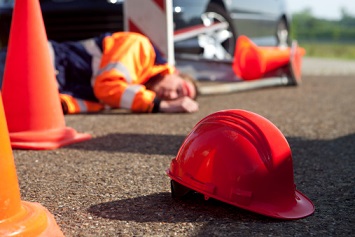Struck-by object is one of OSHA’s Construction Focus Four topics (along with falls, electrocution, and caught-in-between), collectively the four hazards that year-to-year result in more than half the fatalities in the construction industry.
For 2016, the Bureau of Labor Statistics reported that contact with objects or equipment caused 761 fatalities in the entire workforce. Among the Focus Four, struck-by comprises the widest range of individual hazards, consisting of struck by a flying object, a falling object, a swinging or slipping object, or a rolling object.
- A flying object hazard exists when something has been thrown, hurled, or propelled across space. It can include instances when a piece of material separates from a tool, machine, or other equipment, striking a worker.
- A falling object hazard includes instances where the injured person is crushed, pinned, or caught under a falling object; this hazard does not include collapsing material or structures.
- A swinging object hazard typically involves loads being lifted by a crane or hoist that is being improperly operated; winds can also cause a suspended load to swing.
- A rolling object hazard includes instances in which the worker is struck or run over by a moving vehicle without being caught under it or instances in which the worker is struck by a sliding object or equipment on the same level.
Prevention
OSHA and other worker safety stakeholders recommend the following preventive practices:
- General
- Workers should wear the proper personal protective equipment for the work environment, such as steel-toe shoes and a hard hat.
- Workers should only operate equipment they are properly trained to use.
- Workers should make sure all safety devices on their equipment are in good working order before use.
- Rolling object
- Check vehicles before use to make sure they are in safe operating condition.
- Always walk behind moving equipment if possible.
- Never obstruct vision by overloading moving equipment.
- Use extra caution around corners and near doorways.
- When large equipment is being operated, always make eye contact with the operator before approaching.
- Falling object
- Securely and neatly store loose materials, particularly those in overhead locations.
- Store heavy objects close to the floor.
- Secure all loads and lift them evenly.
- Entrance into areas below elevated work should be restricted with barricades.
- Workers in elevated locations should avoid throwing tools and other materials to each other.
- Use debris nets, catch platforms, or canopies to catch or deflect falling objects.
- Swinging/slipping objects
- Secure all loads and lift them evenly.
- Do not work under loads as they are being lifted.
- Keep a safe distance from suspended loads.
- Inspect cranes and hoists to see that all components, such as wire rope, lifting hooks, and chains, are in good condition.
- Do not exceed lifting capacity of cranes and hoists.
- Flying objects
- Inspect tools such as saws and lathes to ensure that protective guards are in good condition.
- Wear face shields and safety spectacles or goggles to prevent injury from chips or particles ejected by equipment.
OSHA’s Construction Focus Four: Struck-By Hazards: Instructor Guide can assist employers in training employees on struck-by hazards and how to prevent injury.

